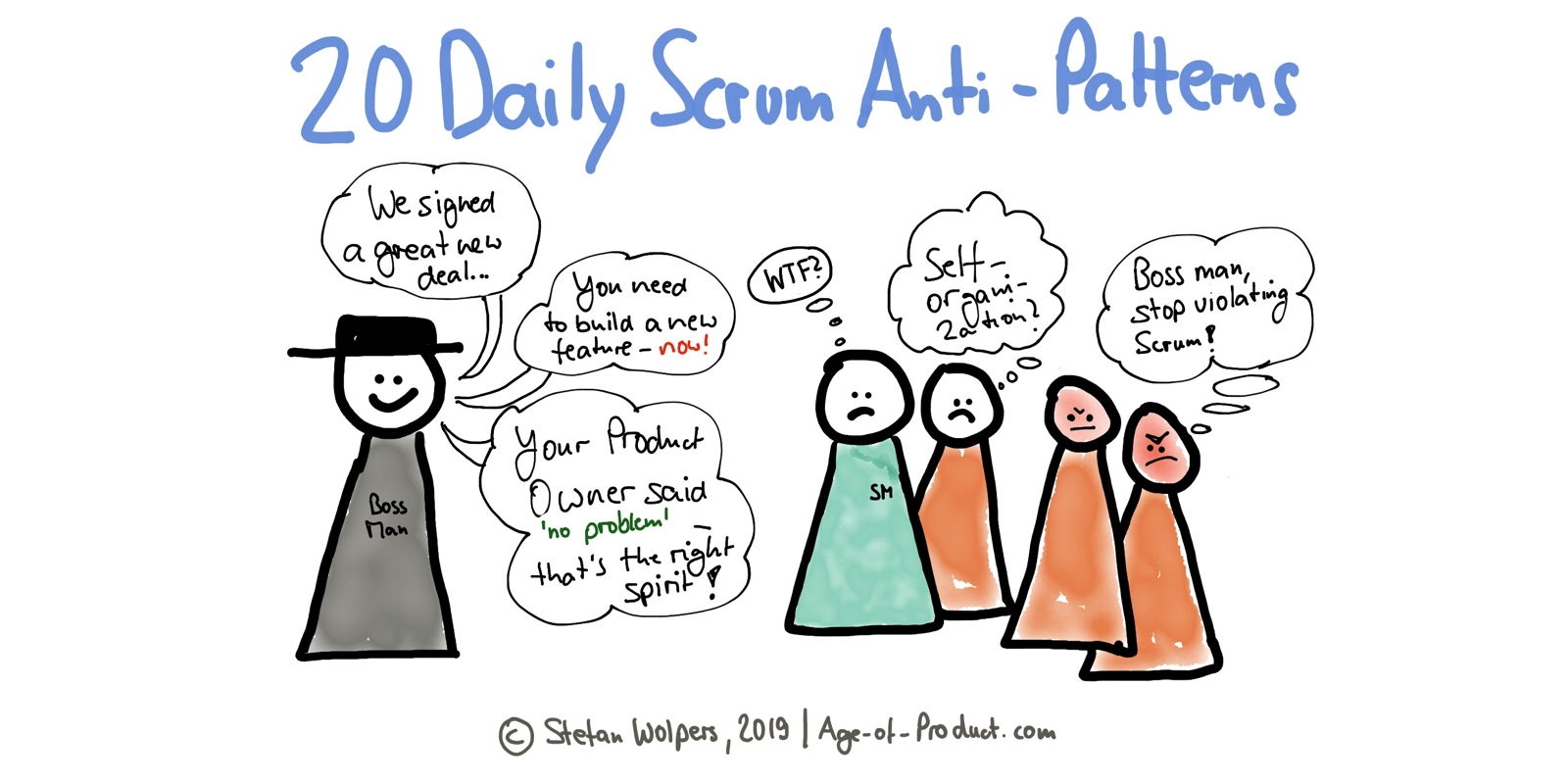Daily Scrum Anti-Patterns: 20 Ways to Improve
TL; DR: 20 Daily Scrum Anti-Patterns
In my experience, the Daily Scrum is the Scrum event with the highest anti-pattern density among all events. Learn more about the Daily Scrum anti-patterns that threaten to derail your transition.

The Purpose of the Daily Scrum
The purpose of the Daily Scrum is clearly described in the Scrum Guide — no guessing is necessary:
The Daily Scrum is a 15-minute time-boxed event for the Development Team. The Daily Scrum is held every day of the Sprint. At it, the Development Team plans work for the next 24 hours. This optimizes team collaboration and performance by inspecting the work since the last Daily Scrum and forecasting upcoming Sprint work. The Daily Scrum is held at the same time and place each day to reduce complexity.
The Daily Scrum is an internal meeting for the Development Team. If others are present, the Scrum Master ensures that they do not disrupt the meeting.
Daily Scrums improve communications, eliminate other meetings, identify impediments to development for removal, highlight and promote quick decision-making, and improve the Development Team’s level of knowledge. This is a key inspect and adapt meeting.
Source: Scrum Guide 2017.
The Daily Scrum is an essential event for inspection and adaption, run by the Development Team, and guiding it for the next 24 hours on its path to achieving the Sprint Goal. The Daily Scrum is hence the shortest planning horizon in Scrum and thus mandatory.
Contrary to popular belief, its 15-minutes timebox is not intended to solve all the issues addressed during the Daily Scrum. It is about creating transparency, thus triggering the inspection. If an adaption of the plan or the Sprint Backlog, for example, is required, the Development Team is free to handle the resulting issues at any time. In my experience, most Daily Scrum anti-patterns result from a misunderstanding of this core principle.
Daily Scrum Anti-Patterns – From Dysfunctional Scrum Teams to Organizational Failures
Typically, a good Scrum Team won’t need more than 10 to 15 minutes to inspect its progress towards the Sprint Goal. Given this short period, it is interesting to observe that the Daily Scrum is often so riddled with anti-patterns. The anti-patterns often cover a broad spectrum, ranging from behaviors driven by dysfunctional Scrum teams to apparent failures at an organizational level.
My unprioritized list of notorious Daily Scrum anti-patterns is as follows:
- No routine: The Daily Scrum does not happen at the same time and the same place every day. (While routine has the potential to ruin every Retrospective, it is helpful in the context of the Daily Scrum. Think of it as a spontaneous drill: don’t put too much thought into the stand-up, just do it. Skipping Daily Scrums can turn out to be a slippery slope: if you skip one Daily Scrums or two, why not skip every second one?)
- Status report: The Daily Scrum is a status report meeting, and Development Team members are waiting in line to “report” progress to the Scrum Master, the Product Owner, or maybe even a stakeholder.
- Ticket numbers only: Updates are generic with little or no value to others. (“(November 03, 2019), I worked on X-123. Today, I will work on X-129.”)
- Problem-solving: Discussions are triggered to solve problems, instead of parking those so they can be addressed after the Daily Scrum.
- Planning meeting: The Development Team hijacks the Daily Scrum to discuss new requirements, to refine user stories, or to have a sort of (sprint) planning meeting
- Orientation lost: The Daily Scrum serves one purpose as it answers a simple question: Are we still on track to meet the Sprint Goal? Or do we need to adapt the plan or the Sprint Backlog or both? Often, the Development Team cannot answer that question immediately. (In that respect, visualizing the progress towards the Sprint Goal is a useful exercise. Removing the Development Team task of maintaining a mandatory burndown chart from the Scrum Guide a few years ago does not imply that a burndown chart is obsolete.)
- No use of work-item age: A Development team member experiences difficulties in accomplishing an issue over several consecutive days and nobody is offering help. (Often, this result is a sign that people either may not trust each other or do not care for each other. Alternatively, the workload of the Development Team has reached an unproductive level as they no longer can support each other. Note: Of course, the Scrum Guide does not mention the ‘work item age.’ However, it has proven to be a useful practice.)
- Monologs: Team members violate the timebox, starting monologs. (60 to 90 seconds per team member should be more than enough time on -ir.)
- Statler and Waldorf: A few team members are commenting on every issue. (Usually, this is not just a waste of time, but also patronizing and annoying.)
- Disrespect I: Other team members are talking while someone is sharing his or her progress with the Development team. (The use of talking tokens among adults to avoid this behavior does not qualify as a solution in my eyes.)
- Assignments: The Product Owner – or even the “Scrum Master” – assign tasks directly to team members.
- Cluelessness: Team members are not prepared for the Daily Scrum. (“I was doing some stuff, but I cannot remember what. Was important, though.”)
- Let’s start the shift: The Daily Scrum acts as a kind of artificial factory siren to start the next shift. (This is a common Taylorism artifact where trust in the Development Team’s capability to self-organize is missing.)
- Disrespect II: Team members are late to the stand-up or do not show up at all. (This poses a massive risk for the Development Team as it is inspecting and probably adapting the plan based on incomplete information thus reducing the probability of achieving the Sprint Goal.)
- Excessive feedback: Team members criticize other team members right away sparking a discussion instead of taking their critique outside the Daily Scrum.
- Overcrowded: The Daily Scrum is ineffective due to a large number of active participants. (There is a reason why the Scrum Guide recommends to limit the number of Development Team members to nine.)
- Talkative chickens: “Chickens” actively participate in the Daily Scrum. (Stakeholders are supposed to listen in but not distract the Development Team members during their inspection.)
- Command & control by the management: Line managers are attending the Daily Scrum to gather “performance data” on individual team members. (This behavior is defying the very purpose of self-organizing teams.)
- “A word, please”: Line managers are waiting until the Daily Scrum is over and then reach out to individual Development Team members for specific reporting from them. (Nice try. However, this hack is also unwanted behavior and distracts the Development Team.)
- Additional Work: The Product Owner or even other stakeholders attempt to introduce new work to the current Sprint during the Daily Scrum. (This behavior may be acceptable for high priority bugs, although the Development Team should be aware of those before the Daily Scrum. Otherwise, the composition of the Sprint Backlog is the sole responsibility of the Development Team.)
Lastly, some teams like to have their Daily Scrum in Slack, particularly those that are not co-located. Using Slack does not manifest an anti-pattern per se; it is the prerogative of the Development Team to run the Daily Scrum in any fashion that serves its purpose: inspect the plan for the next 24 hours to meet the Sprint Goal. (I was even working with a co-located Scrum team that used Slack as their preferred way of having a Daily Scrum. It worked.)
Daily Scrum Anti-Patterns — Conclusion
Given the importance of the Daily Scrum for the success of the Scrum Team’s effort of achieving the Sprint Goal, its anti-patterns density is no surprise. People seem to be either ignorant (or at least less well educated) about its purpose. Or they — intentionally or not — interfere with the Development Team’s self-organization. One way or another, it is a crucial responsibility of the Scrum Master to help all participants to overcome typical Daily Scrum anti-patterns.
What Daily Scrum anti-patterns have you observed? Please share it with us in the comments.
Business & Finance Articles on Business 2 Community
(58)


